Transform your basement into a stylish, functional retreat with these 20 inspiring wall ideas. From sleek waterproof panels to textured stone veneers, each option blends beauty with durability, tackling basement-specific challenges like moisture and limited light. Explore creative finishes, warm colors, and smart lighting integration to elevate your space beyond the ordinary. Whether you’re refreshing concrete walls with bold paint or adding 3D designs for modern flair, the right choice can enhance comfort, boost home value, and reflect your style. These ideas will help you craft an inviting underground space perfect for relaxing, entertaining, or everyday living.
1. Moisture-Resistant Drywall Basement Walls

Moisture-resistant drywall represents the foundation of modern basement wall finishing, specifically engineered to combat the humidity challenges that plague below-grade spaces . This specialized drywall contains additives that resist mold and mildew growth, making it significantly superior to standard drywall in basement environments. The installation process involves proper framing with treated lumber and careful attention to vapor barriers, ensuring long-term performance. While drywall provides a smooth, paintable surface that accommodates various design possibilities, proper sealing and maintenance remain essential for preventing moisture-related issues . Consider pairing moisture-resistant drywall with matte paint finishes, which help camouflage minor imperfections while creating a warm, inviting atmosphere. This approach offers excellent value for homeowners seeking a clean, traditional look that serves as a versatile backdrop for furniture and decor.
2. Waterproof Panel Basement Wall Systems
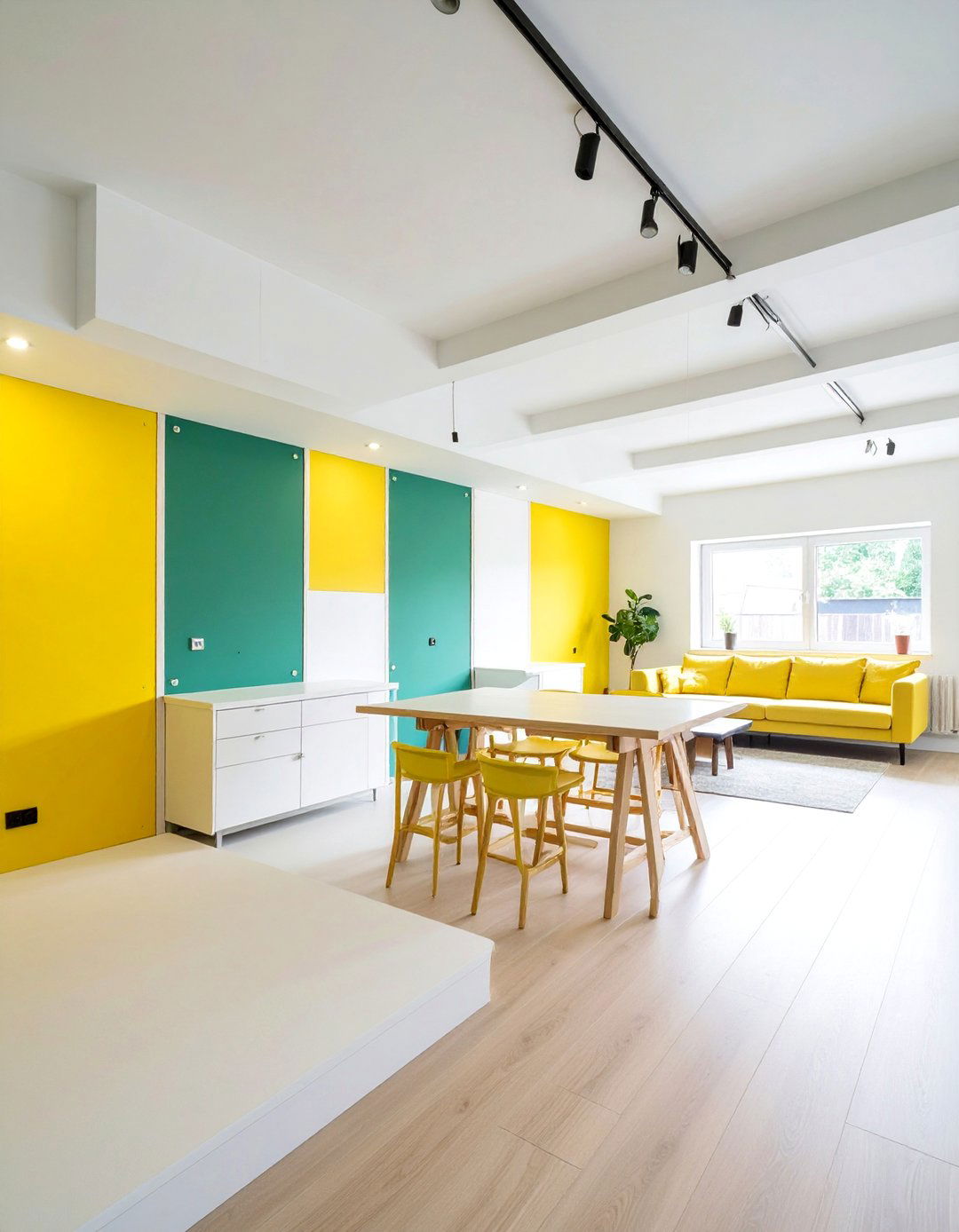
Prefabricated waterproof panels revolutionize basement finishing by combining insulation, moisture protection, and attractive surfaces in one integrated system . These tongue-and-groove panels attach directly to concrete walls, eliminating the need for traditional framing while providing superior moisture resistance. The panels typically feature a drywall front surface that's immediately paintable, backed by foam insulation and a moisture barrier. Installation requires minimal carpentry skills, making them an excellent choice for DIY enthusiasts who want professional-looking results . The system's modular design allows for easy access to utilities behind the walls if needed, while the built-in insulation helps regulate temperature and reduce energy costs. At approximately $80 per panel, this solution offers outstanding value for homeowners prioritizing both functionality and aesthetics in their basement transformation.
3. Reclaimed Wood Basement Wall Paneling
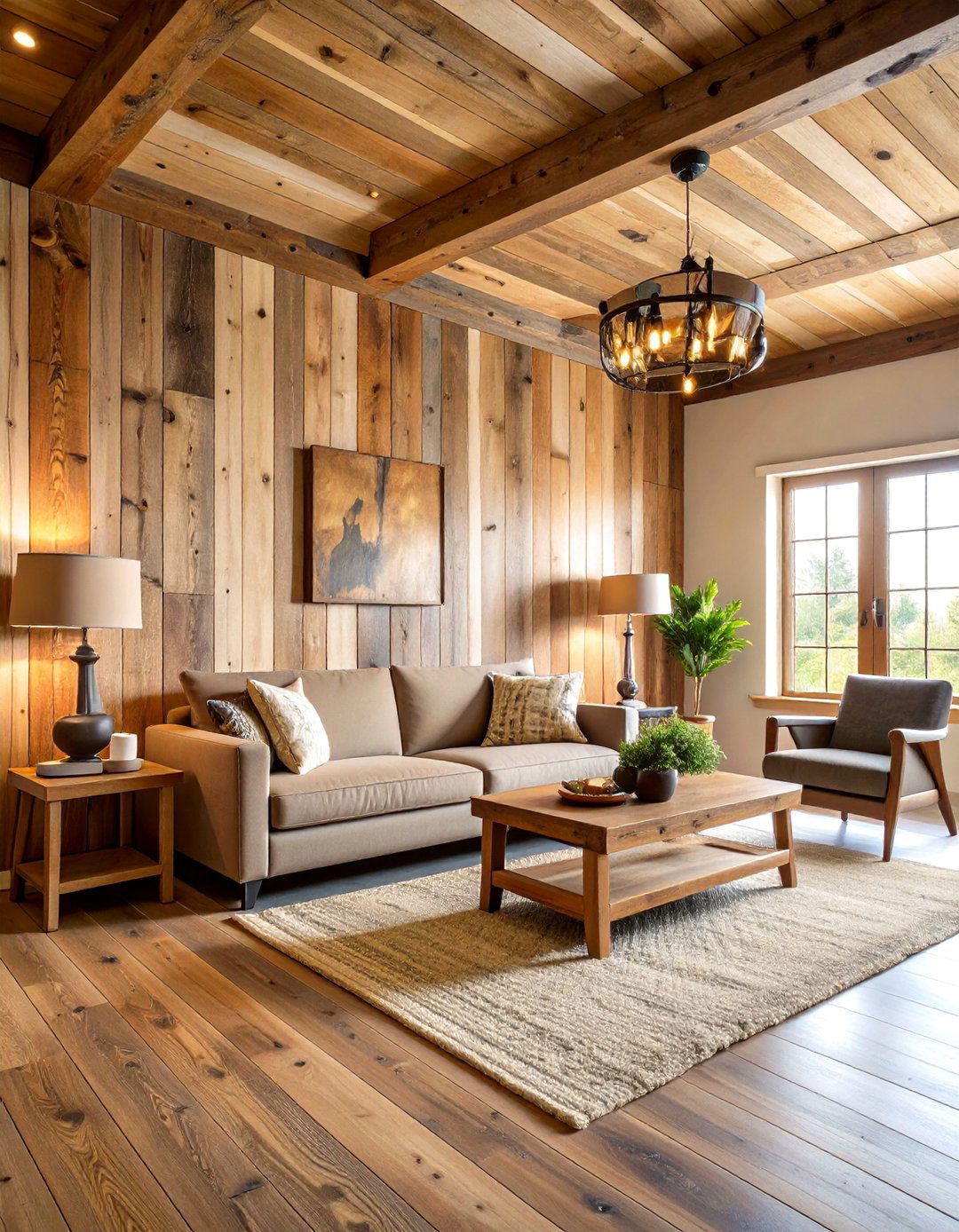
Weathered barn wood and reclaimed lumber bring authentic character to basement walls, creating an instantly cozy, rustic atmosphere that feels both timeless and on-trend. This sustainable approach to basement finishing celebrates the natural beauty of aged wood while providing excellent insulation properties . The varied patina and texture of reclaimed materials add visual interest that can't be replicated with new lumber, making each installation unique. Reclaimed wood works particularly well as accent walls, where it can highlight specific areas like home theaters or reading nooks . Installation involves securing the planks to furring strips, allowing for proper ventilation behind the wood. The natural variations in color and grain pattern create depth and warmth that transforms cold basement spaces into inviting retreats. Consider sealing the wood with appropriate finishes to protect against moisture while preserving its authentic appearance.
4. Industrial Concrete Basement Wall Finish
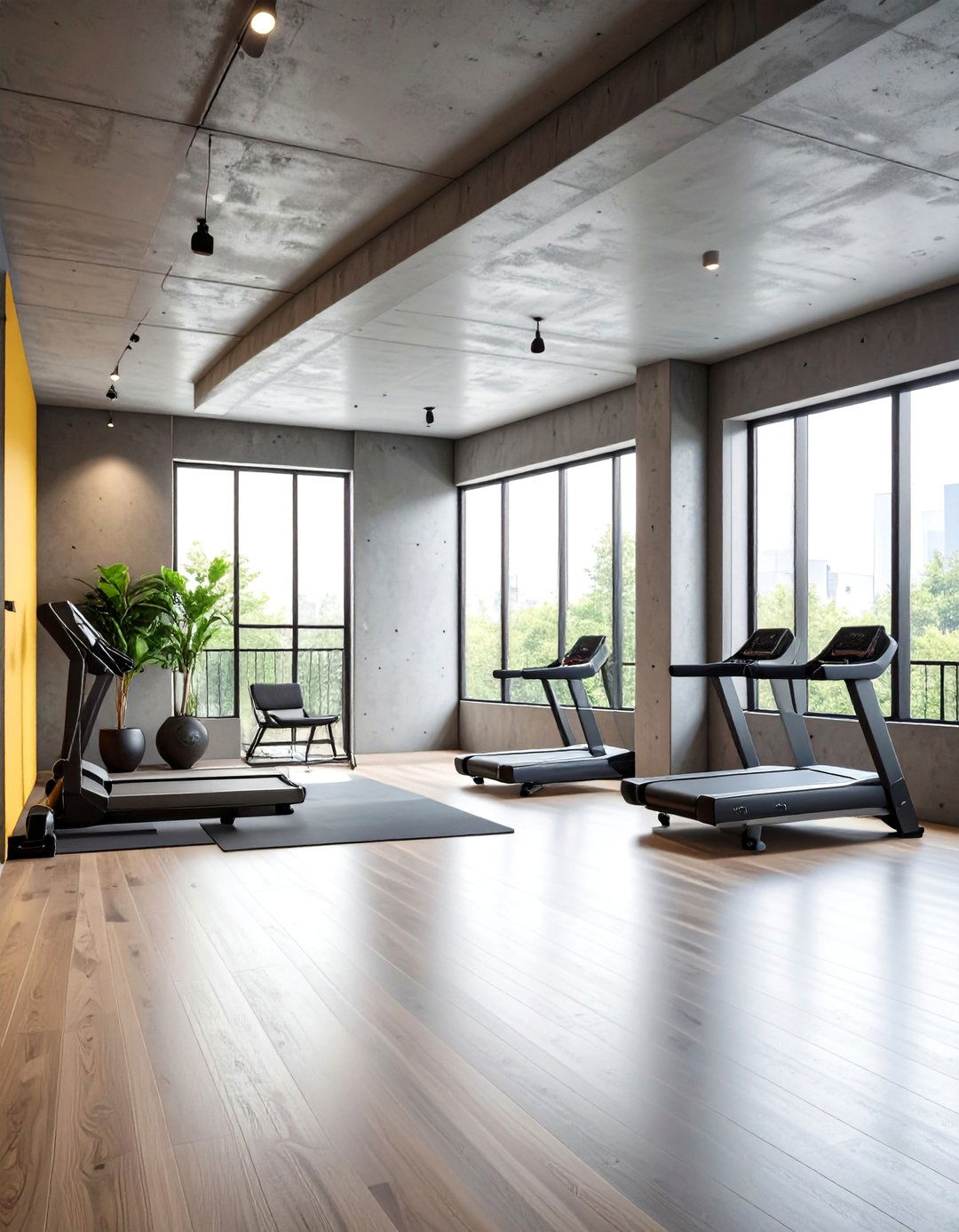
Embracing the raw beauty of concrete transforms basement walls into striking industrial-style focal points that celebrate the authenticity of below-grade construction . This minimalist approach involves cleaning, sealing, and sometimes polishing existing concrete walls to create a sleek, modern aesthetic. The key to success lies in proper preparation, including crack repair and application of high-quality concrete sealers that prevent moisture infiltration while enhancing the surface appearance . Polished concrete walls reflect light beautifully, helping to brighten basement spaces naturally. The thermal mass of concrete helps regulate temperature, contributing to energy efficiency. This approach works exceptionally well in contemporary designs, particularly when combined with strategic lighting and modern furnishings . The durability and low maintenance requirements make concrete finishes ideal for high-traffic basement areas like workshops or fitness spaces.
5. Shiplap Basement Wall Treatment
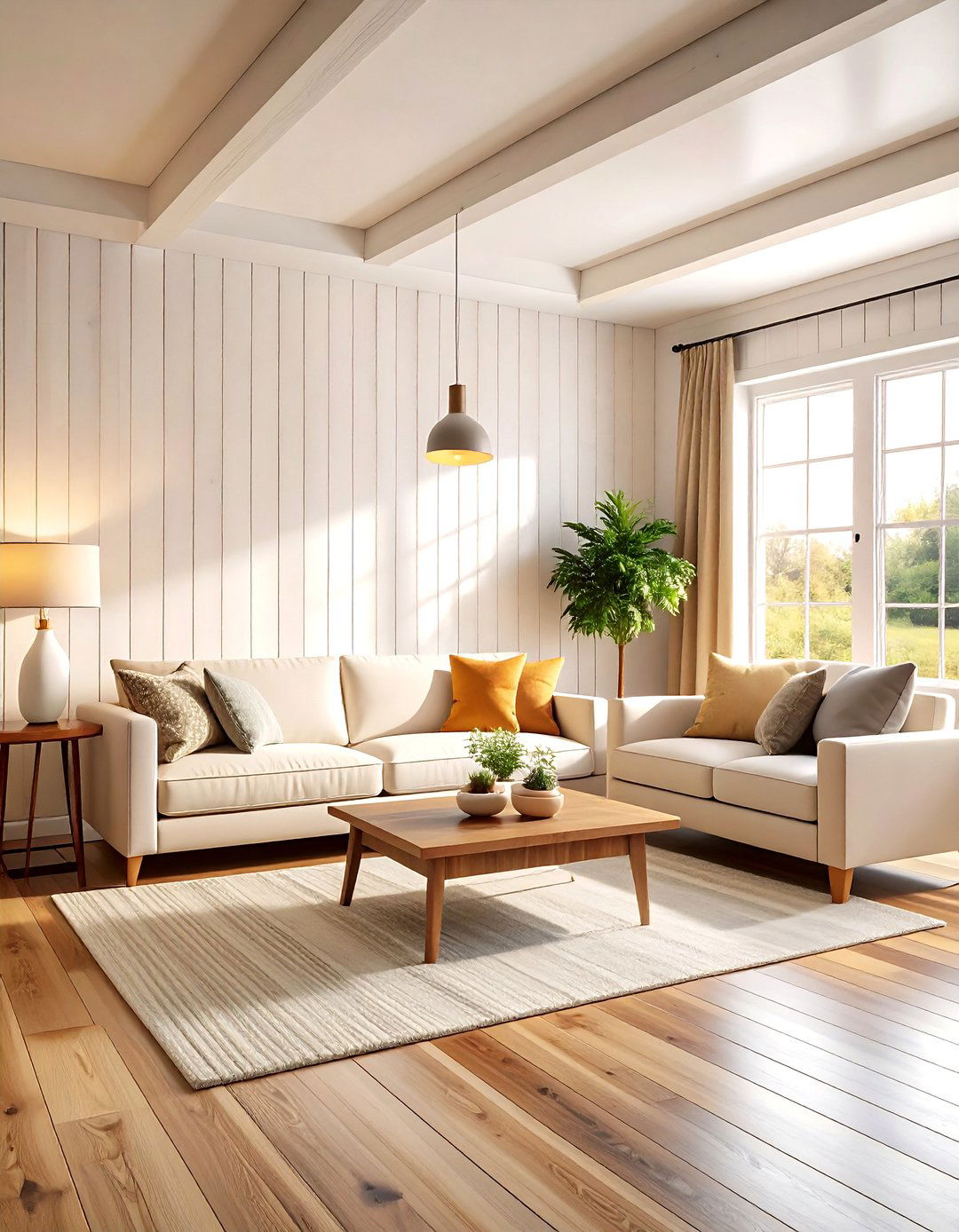
Shiplap's distinctive horizontal lines create visual interest while making basement walls appear wider and more spacious, a crucial advantage in typically confined below-grade areas . This popular wood paneling style features overlapping boards that create subtle shadow lines, adding texture and dimension to otherwise flat surfaces. The installation process involves attaching individual boards to wall studs, making it accessible for DIY enthusiasts with basic carpentry skills. Shiplap can be painted in any color to match your design scheme, from classic white for a farmhouse look to bold colors for contemporary spaces . The wood provides natural insulation properties while hiding minor wall imperfections. Consider using moisture-resistant MDF or properly sealed wood to ensure longevity in basement environments. This versatile treatment works equally well covering entire walls or creating striking accent features.
6. Stone Veneer Basement Wall Accents
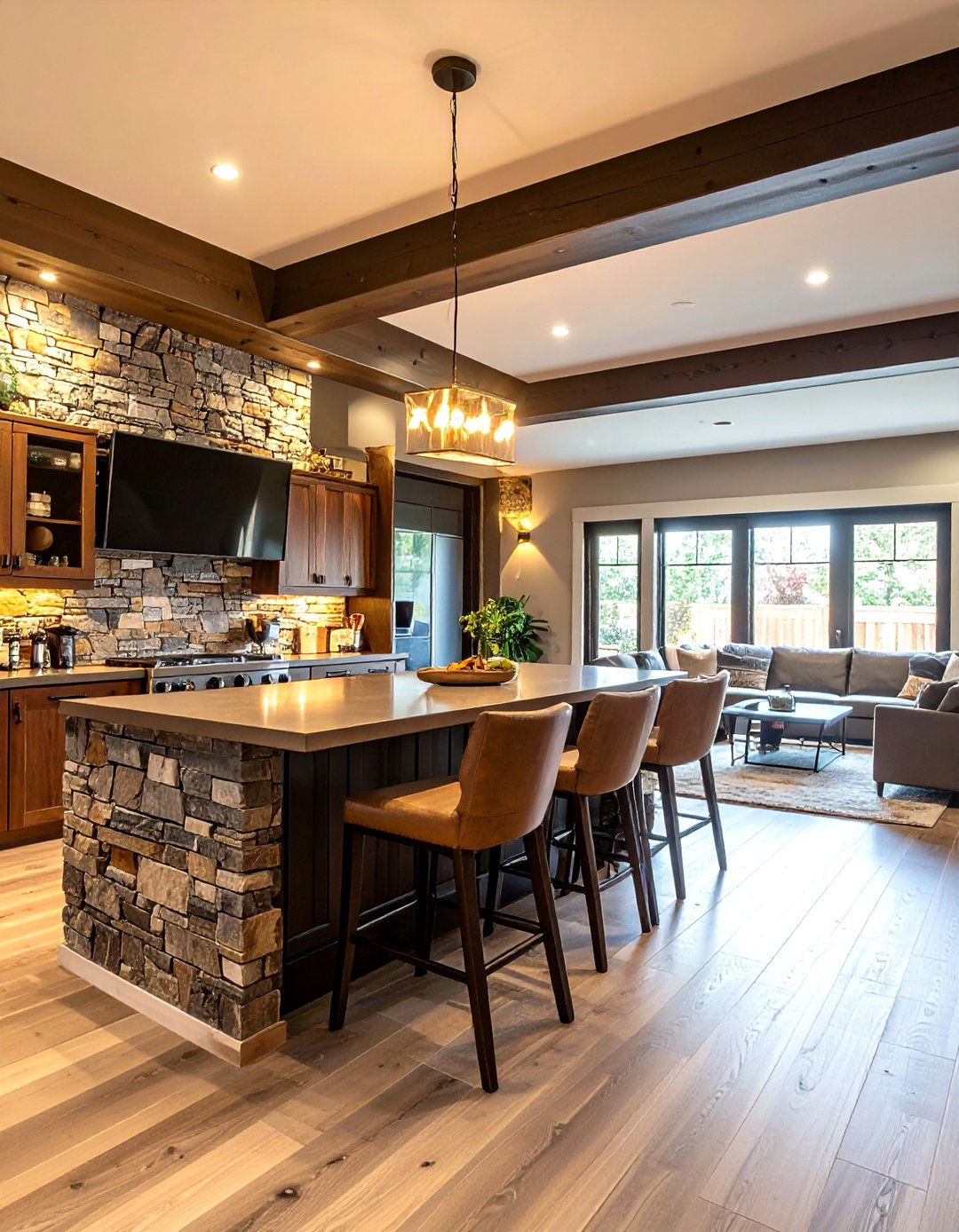
Natural stone veneer brings the timeless beauty of masonry to basement walls without the weight and expense of full stone construction . These thin stone slices attach to existing walls using adhesive, creating authentic-looking stone surfaces that add substantial visual weight and texture. The variety of available stones—from rustic fieldstone to elegant slate—allows for customization to match any design aesthetic. Stone veneer works particularly well around fireplaces, behind wet bars, or as dramatic accent walls that serve as focal points in entertainment areas . The natural variations in color and texture create depth and interest that can't be achieved with painted surfaces. While installation requires some skill, the dramatic transformation justifies the effort. Stone veneer also provides excellent thermal mass, helping to regulate basement temperatures naturally. Consider combining stone with strategic lighting to enhance the natural textures and create stunning visual effects.
7. Three-Dimensional Basement Wall Panels

Three-dimensional wall panels represent the cutting edge of basement design, creating sculptural surfaces that add depth, texture, and visual drama to underground spaces . These innovative panels, available in materials ranging from wood and acrylic to felt and PVC, transform flat walls into dynamic architectural features. The installation process is surprisingly straightforward, with most panels being lightweight and featuring simple mounting systems that make them DIY-friendly . The textured surfaces create interesting shadow patterns as lighting angles change throughout the day, adding movement and life to basement spaces. Different patterns and materials can accommodate various design styles, from modern geometric designs to organic, nature-inspired forms . Beyond aesthetics, many 3D panels offer sound-dampening properties, making them excellent choices for media rooms or home offices. The ability to cover minor wall imperfections while creating stunning visual impact makes these panels increasingly popular among homeowners seeking dramatic basement transformations.
8. Painted Basement Wall Designs

Strategic paint application transforms basement walls into canvases for creativity, offering the most budget-friendly approach to dramatic basement makeovers . Modern paint techniques extend far beyond simple color application, incorporating geometric patterns, ombré effects, and color-blocking designs that create visual interest and personality . Dark, moody colors like deep grays and rich blues can create sophisticated, intimate environments that feel more like upscale lounges than utilitarian basements . Proper surface preparation remains crucial, especially on concrete walls where moisture resistance is essential. Waterproof paints designed specifically for basement applications provide protection against seepage while offering excellent coverage and durability . Consider using painter's tape to create crisp geometric designs or hiring artists to create custom murals that reflect your family's interests and personality. The versatility of paint allows for easy updates and seasonal changes, making it perfect for evolving design preferences.
9. Brick Veneer Basement Wall Features
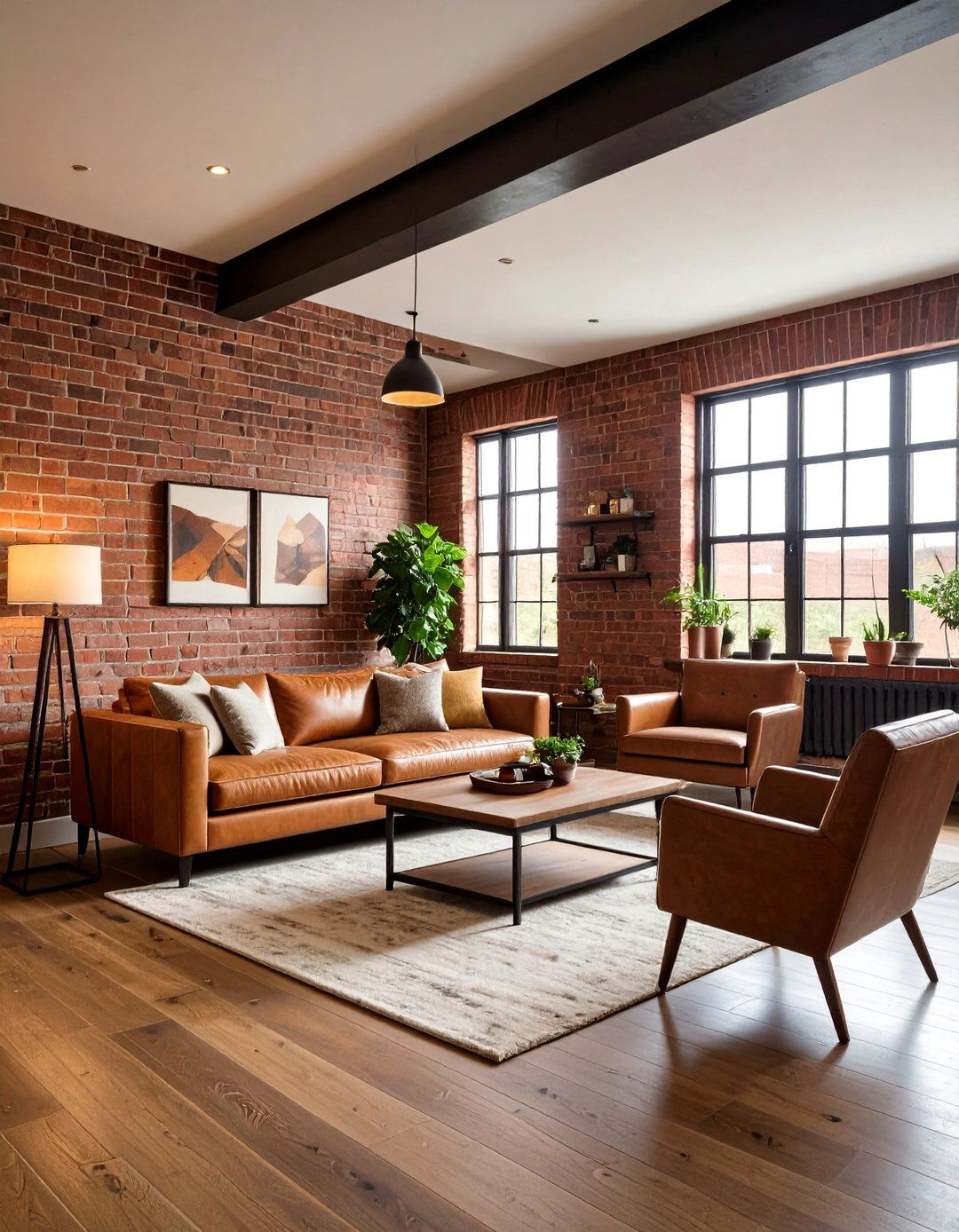
Exposed brick styling brings urban sophistication to basement walls, creating the authentic loft aesthetic that's increasingly popular in modern home design . Whether using genuine reclaimed brick or high-quality brick veneer panels, this treatment adds substantial texture and visual weight that transforms ordinary basement spaces into sophisticated entertainment areas . The warm, earthy tones of brick complement virtually any color scheme while providing timeless appeal that won't date quickly. Brick can be left in its natural state for rustic charm or painted for a more contemporary look, with white-painted brick being particularly effective at brightening dark basement spaces . The installation process involves securing brick veneer to existing walls with appropriate adhesives and mortar, creating authentic-looking results. Brick veneer works exceptionally well as accent walls, particularly behind seating areas or as backdrops for entertainment centers . The thermal mass of brick helps regulate basement temperatures while providing excellent durability.
10. Beadboard Basement Wall Wainscoting
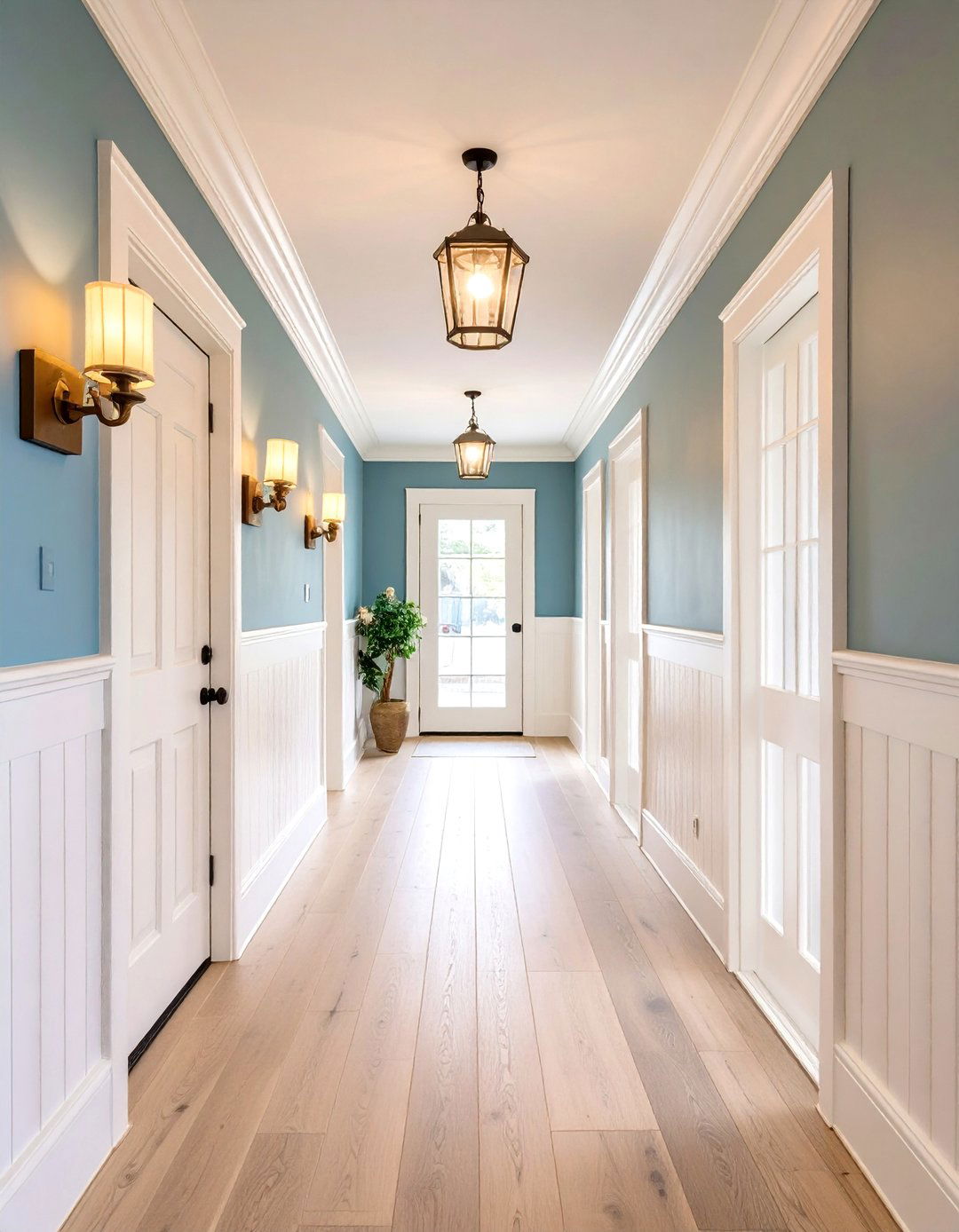
Beadboard wainscoting brings cottage charm to basement walls while providing practical protection against scuffs and moisture in high-traffic areas . This traditional paneling style features narrow vertical boards with distinctive grooves, creating texture and visual interest that works well in both casual and formal basement designs. Installation typically involves covering the lower portion of walls to a height of three to four feet, with the upper walls painted or wallpapered . The horizontal visual break created by wainscoting makes basement ceilings appear higher while adding architectural detail that elevates the space. Beadboard can be painted in any color to match your design scheme, from classic white for a clean, traditional look to bold colors for contemporary appeal . The moisture-resistant properties of properly sealed beadboard make it ideal for basement applications. Consider extending beadboard higher on walls in areas prone to moisture, such as near laundry facilities or wet bars.
11. Metal Accent Basement Wall Panels
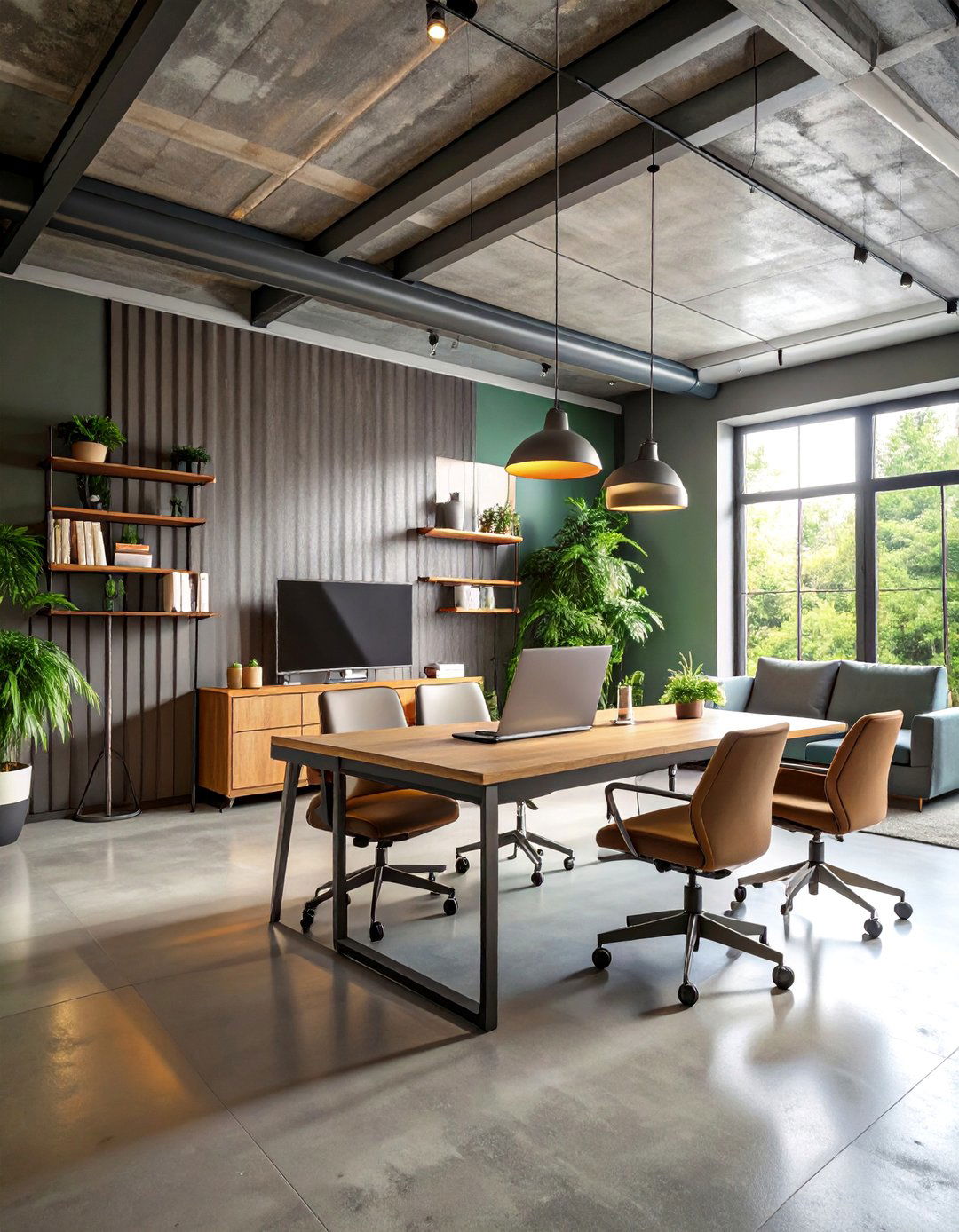
Metallic finishes bring unexpected glamour to basement walls, reflecting light beautifully while creating sophisticated, contemporary environments . Corrugated metal panels, brushed aluminum sheets, and other industrial materials offer unique textures and finishes that work particularly well in modern basement designs . These materials provide excellent moisture resistance while requiring minimal maintenance, making them practical choices for basement applications. The reflective properties of metal surfaces help brighten basement spaces by bouncing available light around the room . Installation involves securing panels to wall studs with appropriate fasteners, creating clean, contemporary lines. Metal accents work particularly well in combination with other materials, such as wood or stone, creating interesting contrasts and visual layering . Consider using metal panels as accent features rather than covering entire walls, which can feel cold or industrial. The durability and unique aesthetic appeal of metal make it an excellent choice for modern basement transformations.
12. Wallpaper Basement Wall Treatments
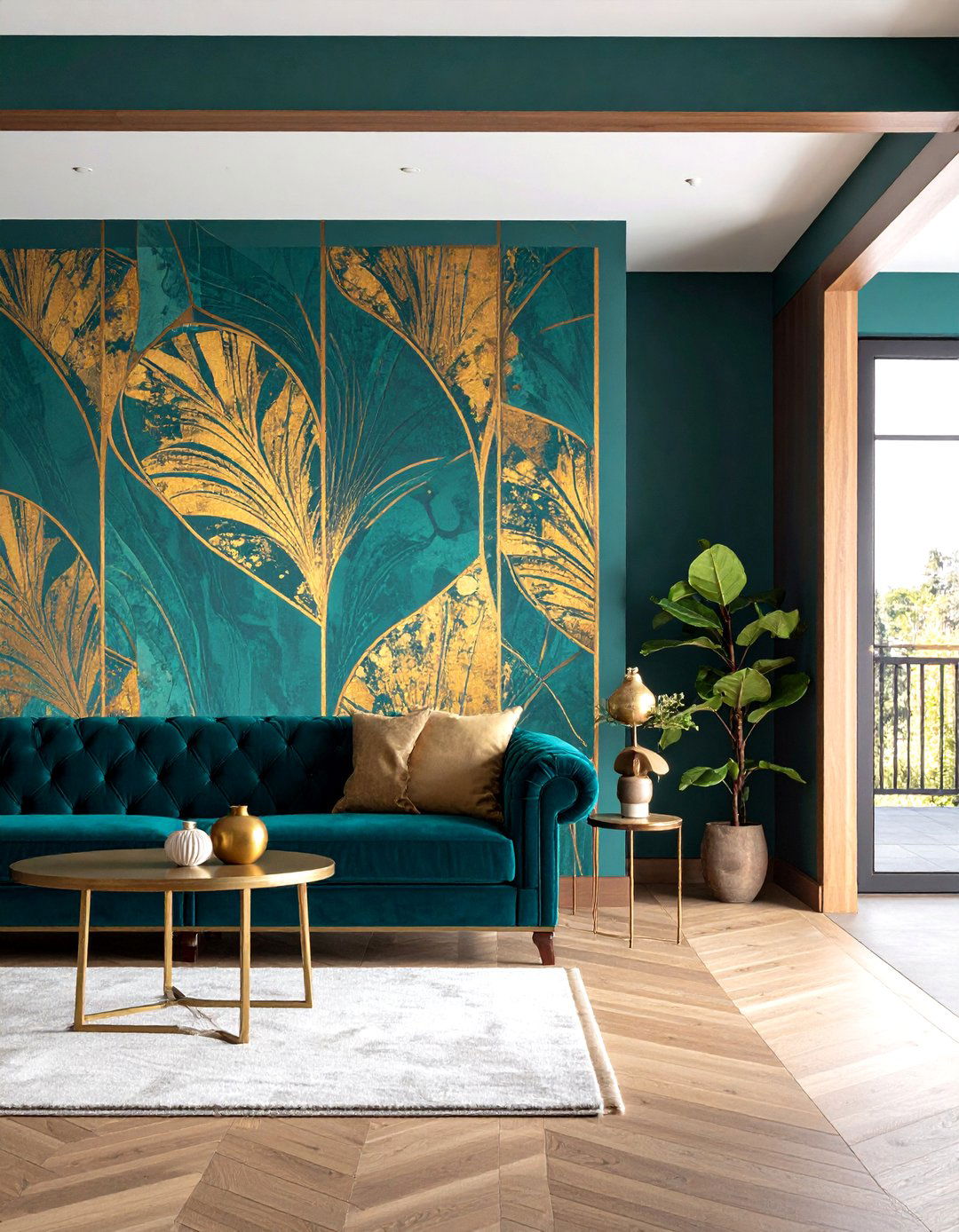
Contemporary wallpaper designs transform basement walls into artistic focal points, offering endless possibilities for pattern, texture, and color that can completely redefine underground spaces . Modern wallpapers designed for basement applications feature moisture-resistant backings and fade-resistant inks that maintain their beauty in challenging below-grade environments . Current trends favor large-scale patterns, abstract designs, and artistic motifs that create visual impact without overwhelming smaller basement spaces . Strategic wallpaper placement, such as accent walls or recessed areas, provides maximum impact while remaining cost-effective . The installation process has been simplified with peel-and-stick options that make wallpaper accessible to DIY enthusiasts. Professional-grade wallpapers offer superior durability and can withstand the unique challenges of basement environments . Consider wallpaper as a way to introduce personality and style that would be difficult to achieve with paint alone, particularly in spaces where bold design statements are desired.
13. Built-in Storage Basement Wall Solutions
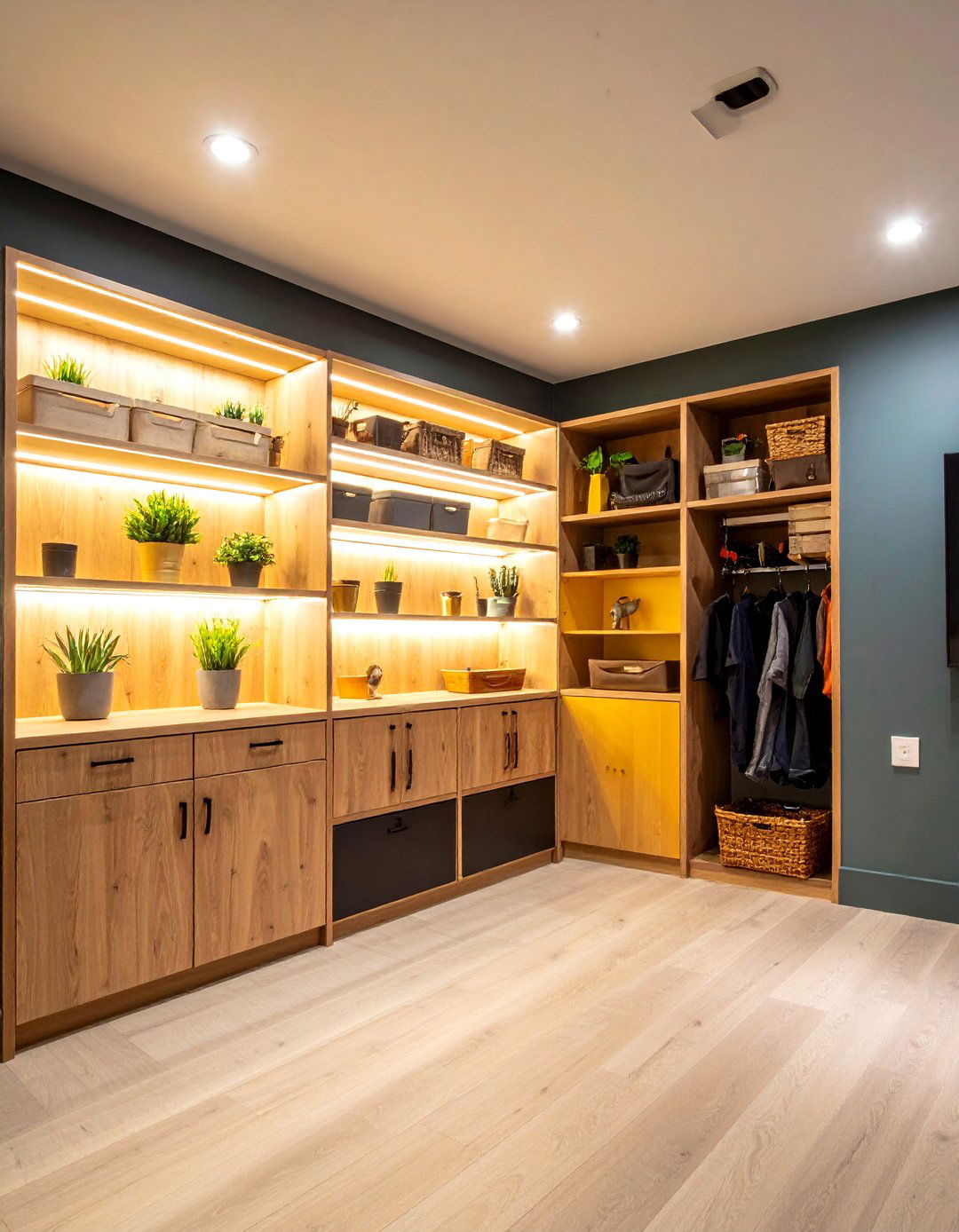
Integrating storage directly into basement walls maximizes functionality while maintaining clean, organized aesthetics that make the most of limited square footage . Custom-built shelving, cabinets, and cubbies transform walls into hardworking organizational systems that serve multiple purposes. Built-in entertainment centers, bookshelves, and storage benches create architectural interest while providing practical solutions for basement living . The key to success lies in planning storage solutions that complement your basement's intended use, whether for recreation, work, or relaxation. Materials should be moisture-resistant and durable, with proper ventilation to prevent mold and mildew growth . Consider incorporating lighting within built-in storage to enhance functionality and create ambient lighting effects. Custom millwork can be designed to hide utilities, create display areas, and provide hidden storage that maintains the aesthetic integrity of your basement design . This approach offers excellent long-term value by maximizing usable space while creating unique, personalized environments.
14. Textured Basement Wall Finishes
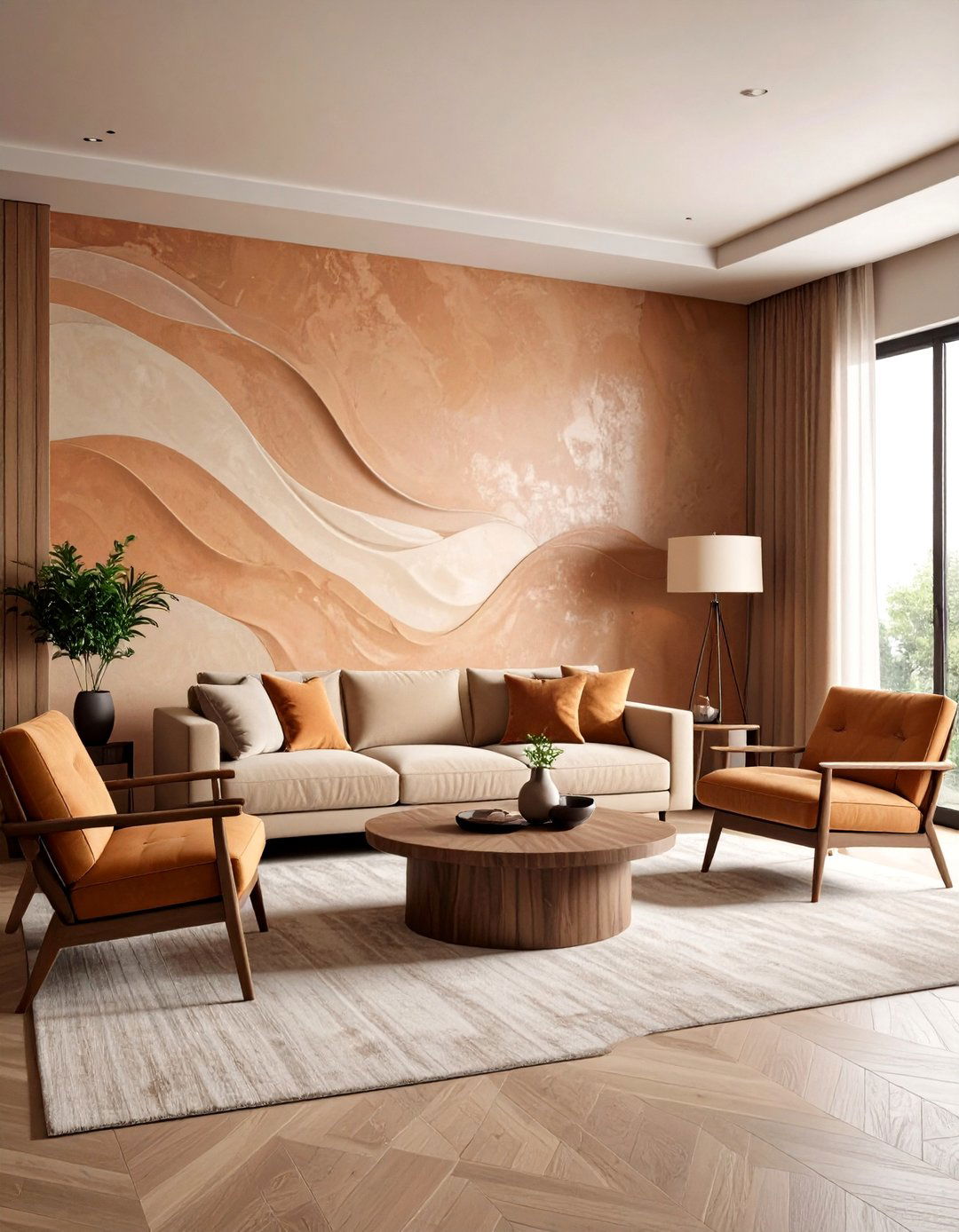
Textured finishes add tactile interest and visual depth to basement walls, creating surfaces that engage the senses while effectively hiding minor imperfections . Techniques such as venetian plaster, stucco, and specialized paint applications create unique surfaces that can't be replicated with standard finishing methods . These finishes work particularly well in basement environments where moisture resistance is important, as many textured products are inherently water-resistant. The play of light and shadow across textured surfaces creates dynamic visual interest that changes throughout the day . Installation typically requires professional expertise to achieve optimal results, though some textured paint products are designed for DIY application. Textured finishes can be colored to match any design scheme, from subtle neutral tones to bold, dramatic shades . Consider using textured finishes as accent features rather than covering entire basements, which can feel overwhelming. The durability and unique aesthetic appeal make textured finishes excellent investments for basement transformations.
15. Geometric Pattern Basement Wall Designs

Geometric patterns create striking visual impact on basement walls, using mathematical precision to add modern sophistication and architectural interest to underground spaces . These designs can be achieved through various methods, including painted patterns, wallpaper, vinyl decals, or even three-dimensional panel arrangements . The key to successful geometric design lies in careful planning and precise execution, with patterns that complement rather than overwhelm the space. Bold, contrasting colors can create dramatic effects, while subtle tonal variations offer sophisticated elegance . Geometric patterns work particularly well in modern basement designs, where clean lines and contemporary aesthetics are prioritized . Consider using painter's tape to create crisp lines when painting geometric patterns, or explore removable wall decals for temporary design flexibility. The versatility of geometric designs allows for customization to match any color scheme or design preference . These patterns can make basement walls feel more dynamic and contemporary while serving as conversation-starting focal points.
16. Acoustic Basement Wall Panels
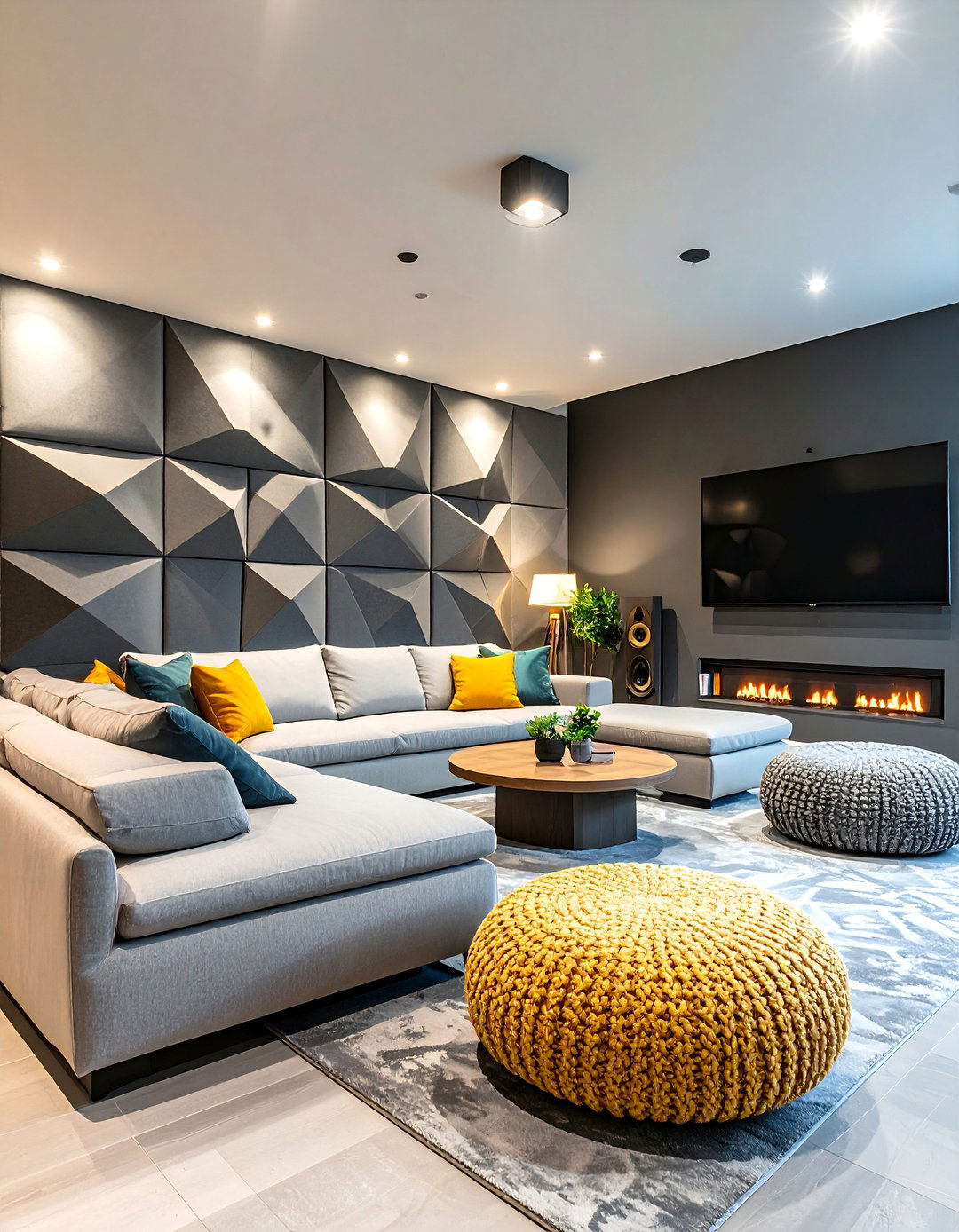
Sound-dampening wall panels serve dual purposes in basement environments, improving acoustics while adding sophisticated texture and visual interest to entertainment spaces . These specialized panels are particularly valuable in basements used for music, media rooms, or home offices where noise control is essential . Materials range from fabric-wrapped acoustic panels to decorative foam designs that can be customized to match any aesthetic preference. Modern acoustic panels often feature attractive designs that make them decorative elements rather than purely functional additions . Installation typically involves mounting panels to walls with appropriate hardware, creating both functional and aesthetic improvements. The improved acoustics create more comfortable environments for conversation and entertainment while reducing noise transmission to other parts of the home . Consider combining acoustic panels with other wall treatments to create visually interesting compositions that serve multiple purposes. Felt panels, in particular, offer excellent sound absorption while providing soft, tactile surfaces that add warmth to basement spaces .
17. Mirrored Basement Wall Accents
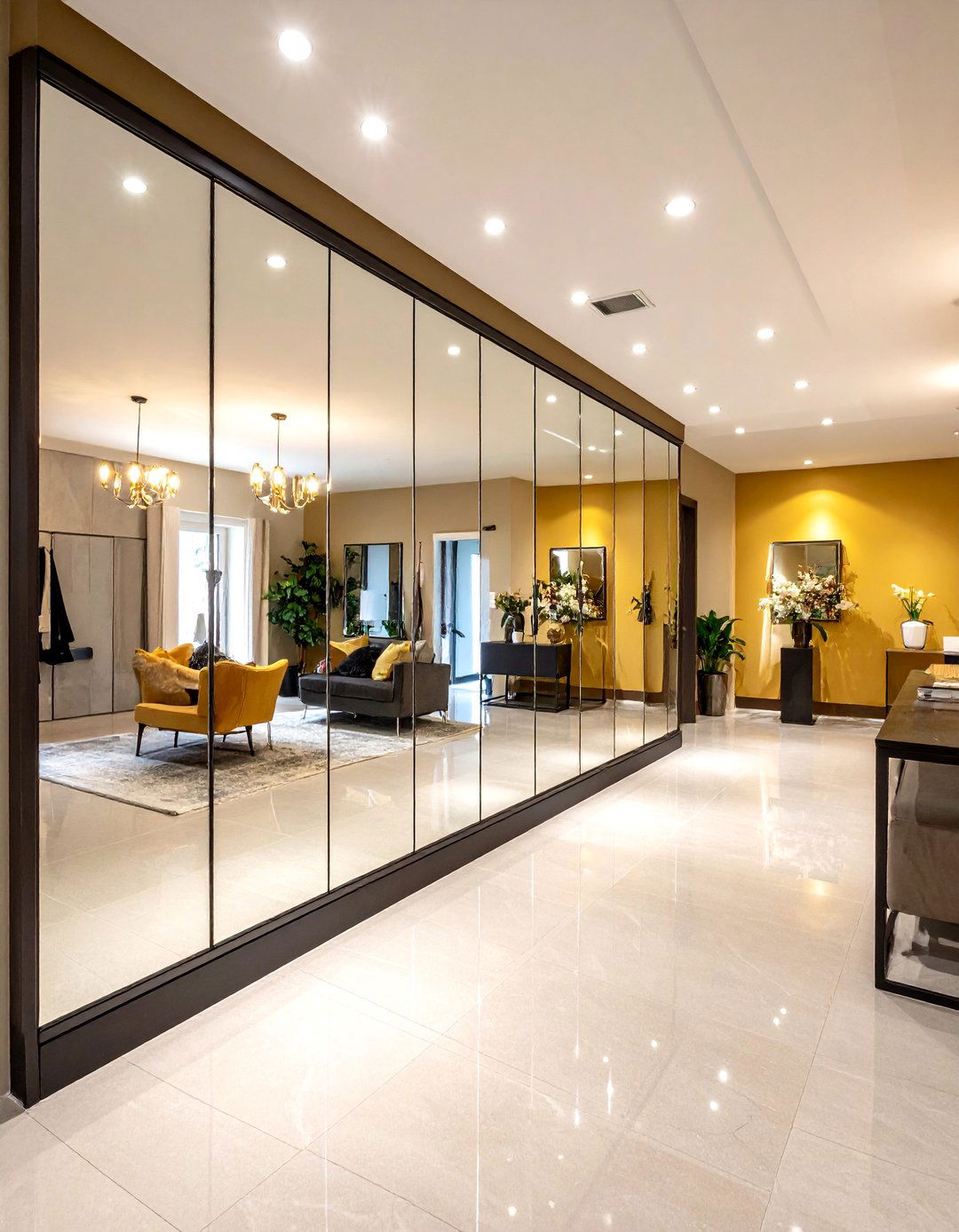
Mirrored wall treatments create the illusion of expanded space while reflecting light throughout basement areas, making them appear larger and brighter than their actual dimensions . Strategic mirror placement can double the apparent size of basement rooms while creating stunning visual effects that add glamour and sophistication . Modern mirror installations go beyond simple wall-mounted pieces, incorporating mirror tiles, panels, and even full mirror walls that serve as dramatic focal points . The reflective properties of mirrors help distribute available light more effectively, addressing one of the primary challenges in basement design. Installation requires careful planning to ensure proper support and safety, particularly with larger mirror installations . Consider using mirrors to highlight architectural features or create interesting visual effects when combined with lighting. The versatility of mirror treatments allows for subtle accents or bold statements, depending on your design preferences and the specific needs of your basement space . This approach offers excellent value for homeowners seeking to maximize the perceived size and brightness of their basement areas.
18. Combination Basement Wall Materials
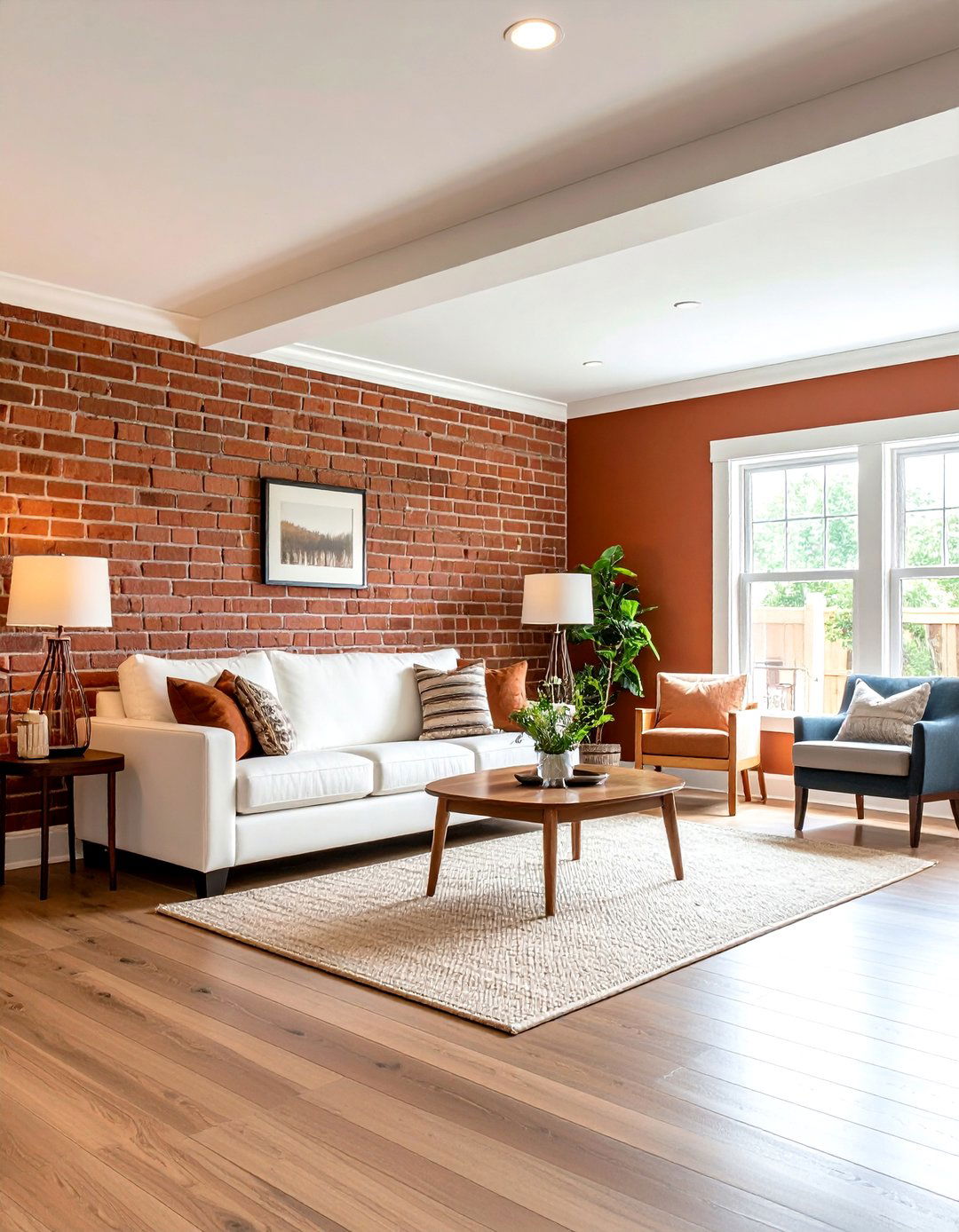
Combining different materials creates visually dynamic basement walls that offer the best characteristics of each component while generating unique, personalized environments . Popular combinations include mixing exposed brick with board-and-batten, pairing wood paneling with painted drywall, or combining stone veneer with smooth plaster surfaces . The key to successful material combinations lies in maintaining visual balance and ensuring that different materials complement rather than compete with each other. Transition points between materials should be carefully planned and executed to create clean, professional-looking results . Consider using architectural features like chair rails or trim pieces to create logical separation points between different materials. The varied textures and finishes create depth and interest that can't be achieved with single-material approaches . This strategy allows for highlighting specific areas or creating zones within larger basement spaces. Material combinations offer opportunities to incorporate both practical and aesthetic elements, maximizing the functional and visual appeal of basement walls .
19. Lighting-Integrated Basement Wall Systems

Integrating lighting directly into basement wall systems creates ambient illumination that transforms underground spaces into warm, inviting environments while highlighting architectural features . LED strip lighting, recessed fixtures, and accent lighting can be incorporated into various wall treatments to create stunning visual effects . Proper lighting design is essential for basement spaces, where natural light is limited and artificial lighting must create comfortable, functional environments . Accent lighting can highlight texture, create dramatic shadows, and draw attention to specific wall features or artwork . Consider using lighting to create visual layers within basement spaces, combining ambient, task, and accent lighting for maximum flexibility. LED technology offers energy-efficient options that generate minimal heat while providing excellent light quality . Integrated lighting systems can be controlled through smart home technology, allowing for customizable lighting scenarios that adapt to different activities and moods . This approach transforms basement walls from static surfaces into dynamic, interactive elements that enhance the overall living experience.
20. Modular Basement Wall Panel Systems
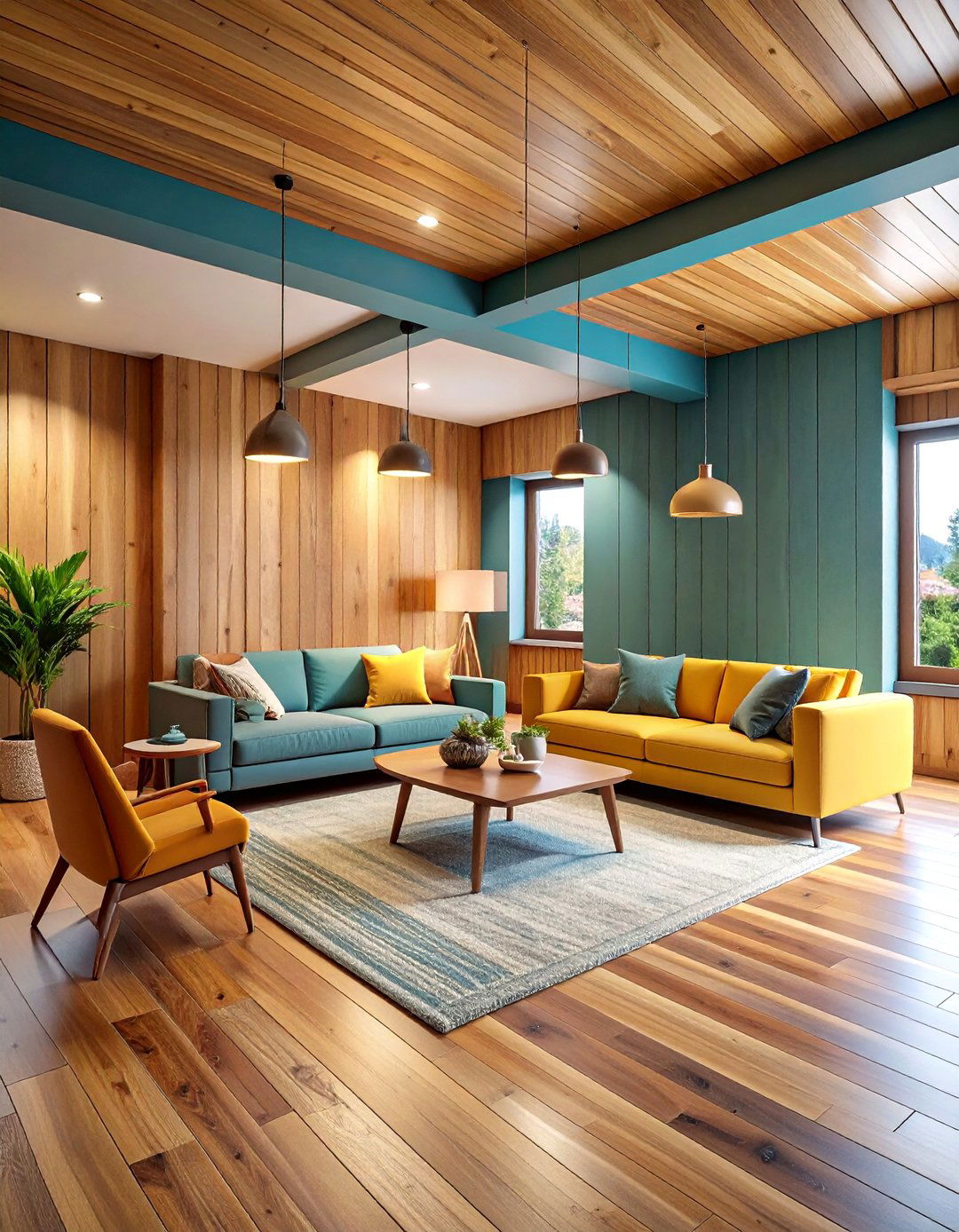
Modular panel systems offer the ultimate in flexibility for basement wall finishing, providing professional-quality results with DIY-friendly installation processes . These systems typically feature interlocking panels that create seamless wall surfaces while incorporating insulation, vapor barriers, and finished surfaces in single components . The tongue-and-groove design ensures tight connections between panels while allowing for easy removal if access to utilities is needed . Modern modular systems are available in various finishes, from paintable surfaces to wood-grain textures and contemporary patterns . Installation requires minimal tools and expertise, making basement finishing accessible to homeowners who prefer DIY approaches. The integrated insulation and moisture barriers provide excellent protection against common basement problems while improving energy efficiency . Consider modular systems for their long-term value, as they can be easily modified or relocated as needs change. The professional appearance and superior performance of quality modular systems make them excellent investments for basement transformations .
Conclusion:
The transformation of basement walls from utilitarian surfaces to stunning design features represents one of the most impactful improvements homeowners can make to their underground spaces . Whether you choose traditional approaches like moisture-resistant drywall and wood paneling or embrace cutting-edge solutions like 3D panels and smart lighting integration, the key lies in selecting materials and designs that address basement-specific challenges while reflecting your personal style . Budget-conscious homeowners can achieve dramatic results with painted finishes and creative techniques, while those seeking luxury can invest in stone veneer, custom millwork, and professional-grade modular systems . Remember that proper moisture management remains fundamental to any basement wall treatment, making waterproofing and vapor barriers essential components of successful basement transformations . The diverse range of available materials, from acoustic panels and geometric patterns to mirrored accents and textured finishes, ensures that every basement can become a unique expression of its owner's vision . With careful planning and appropriate material selection, your basement walls can become the foundation for creating valuable, functional living space that rivals any area of your home .



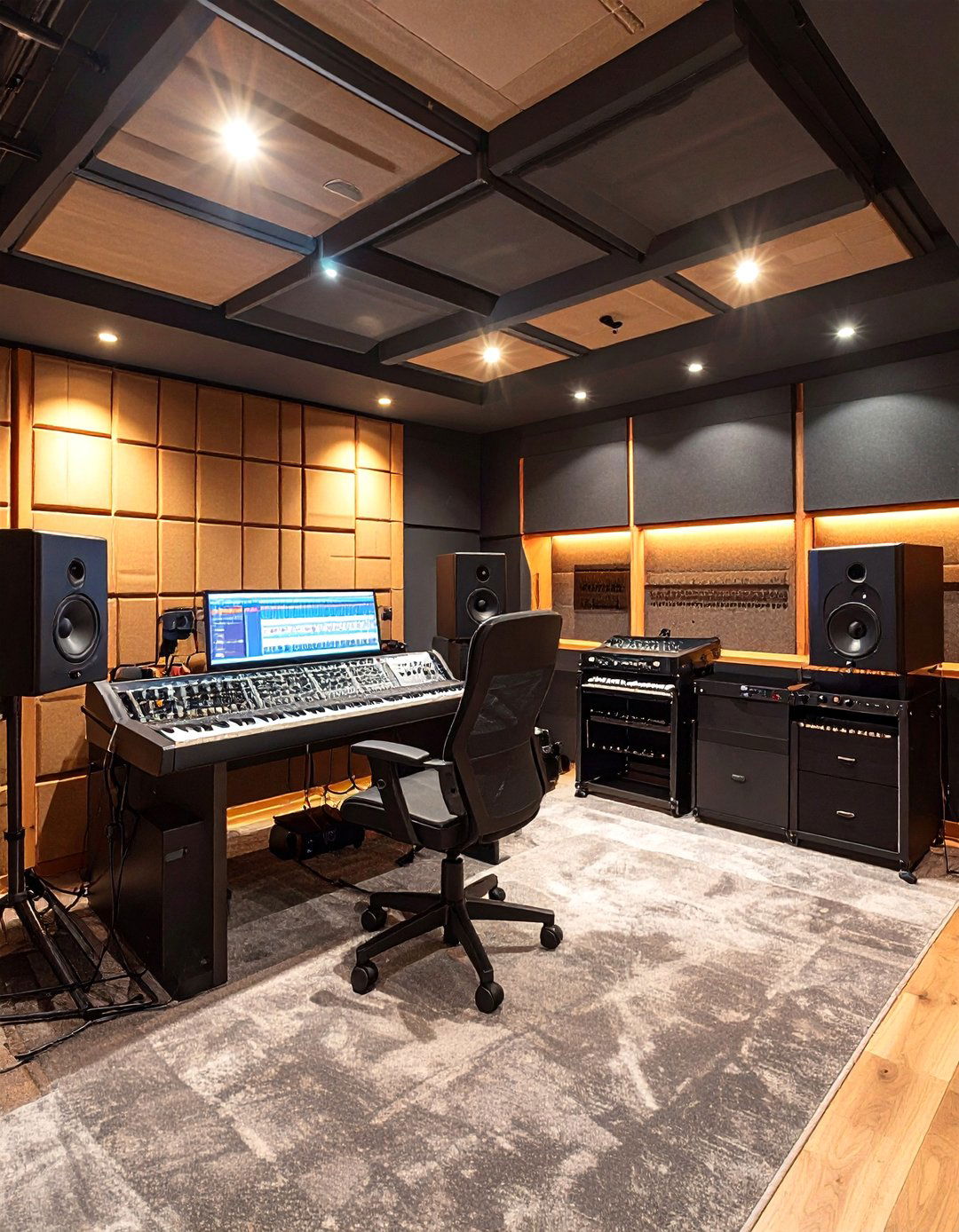
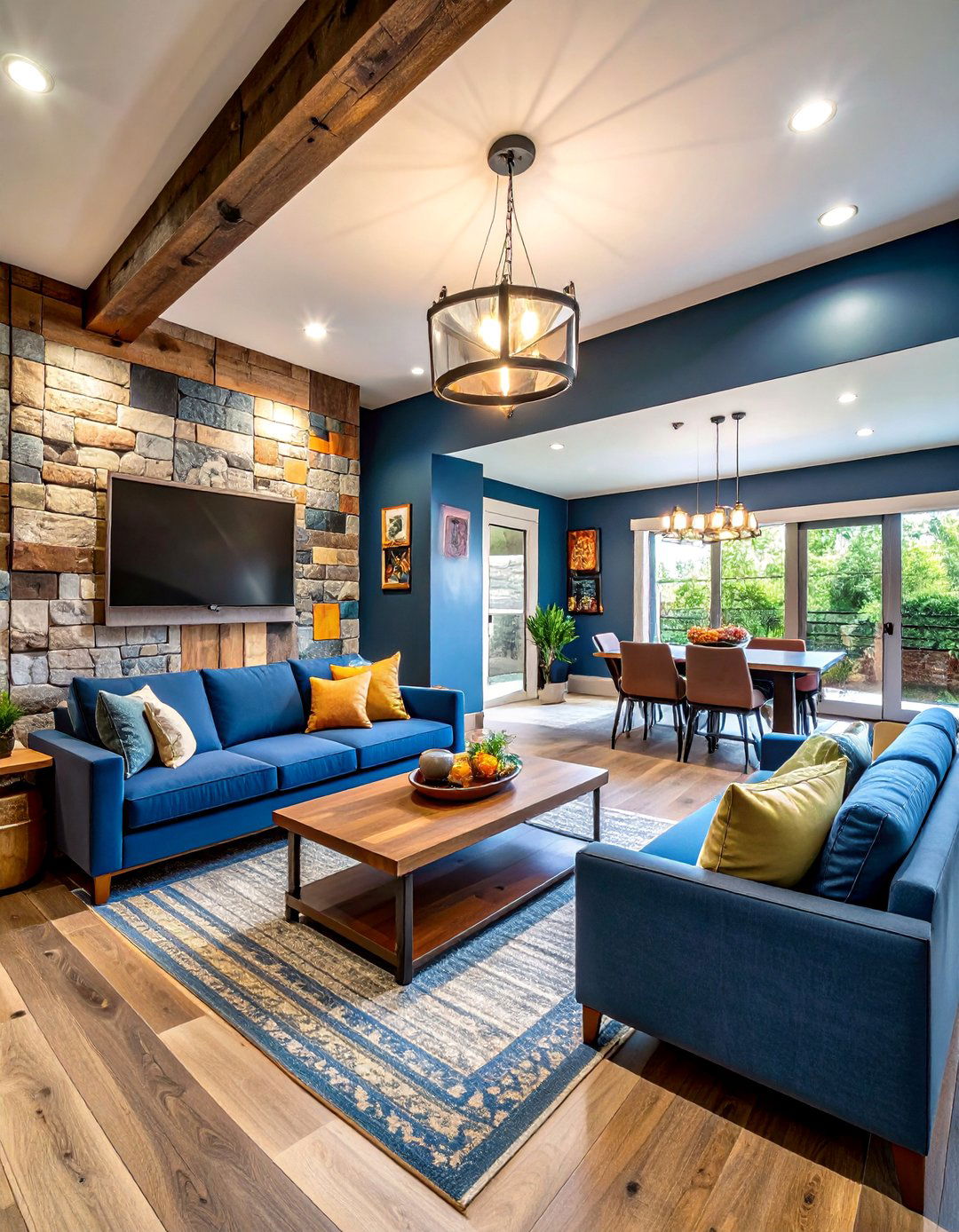
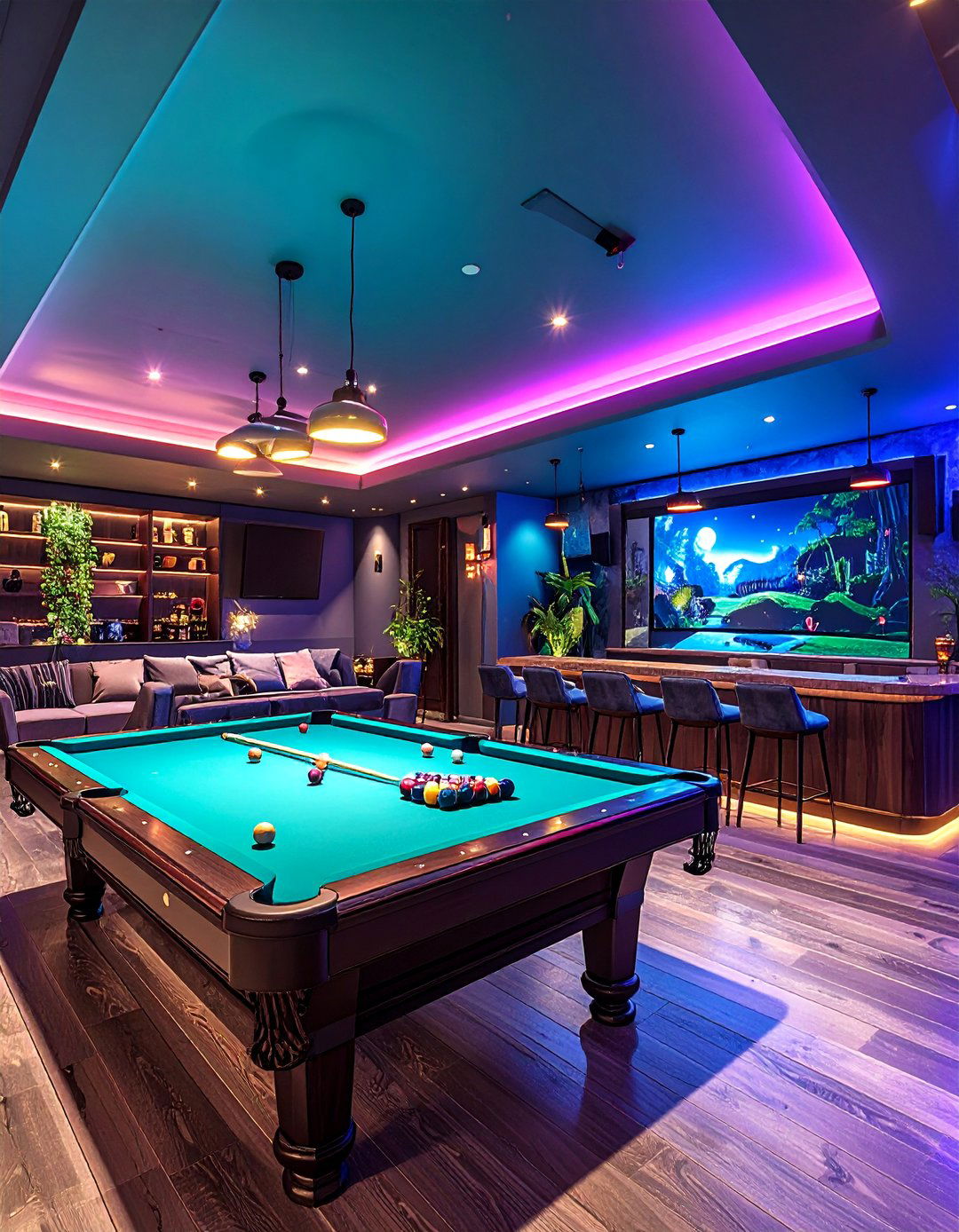
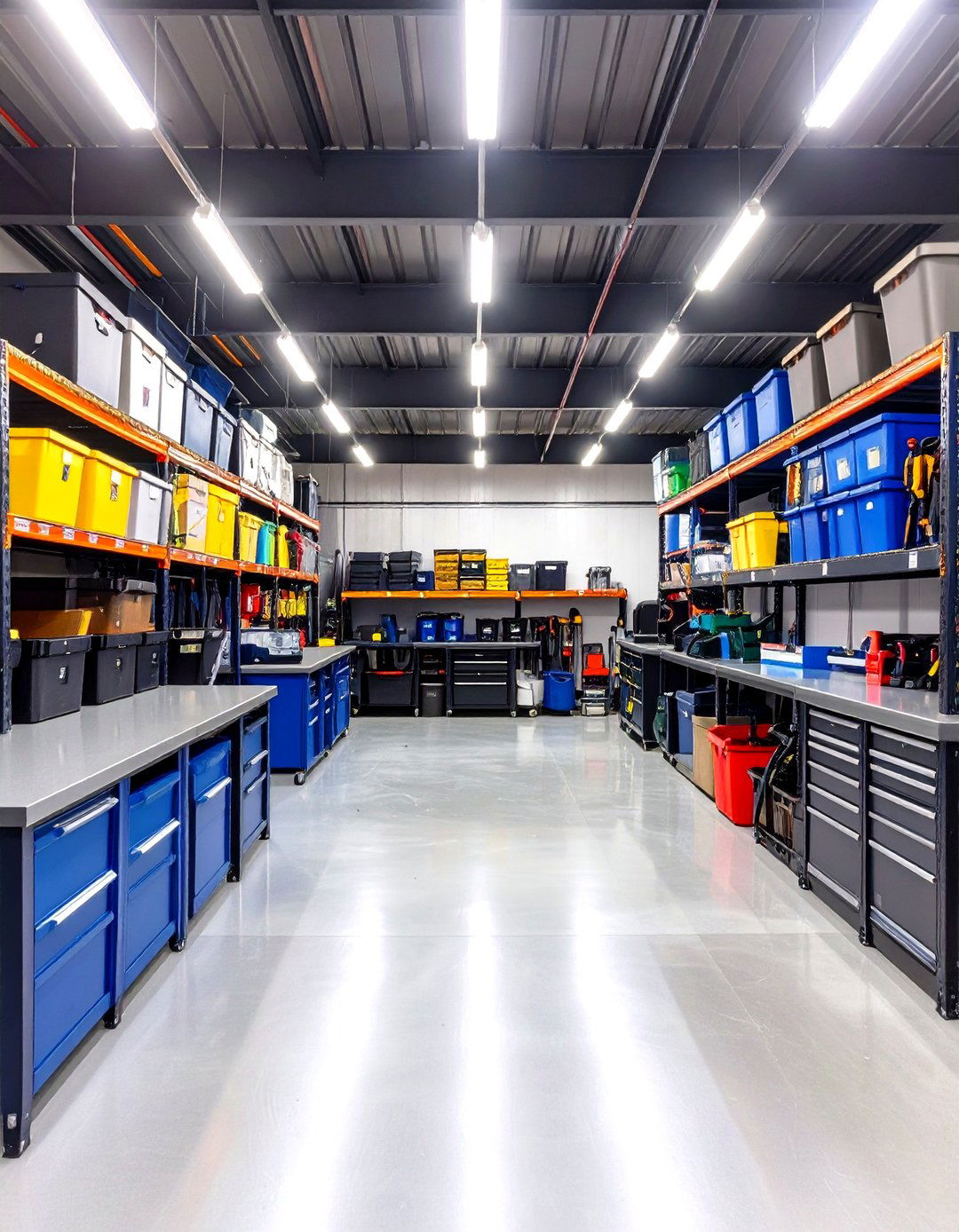
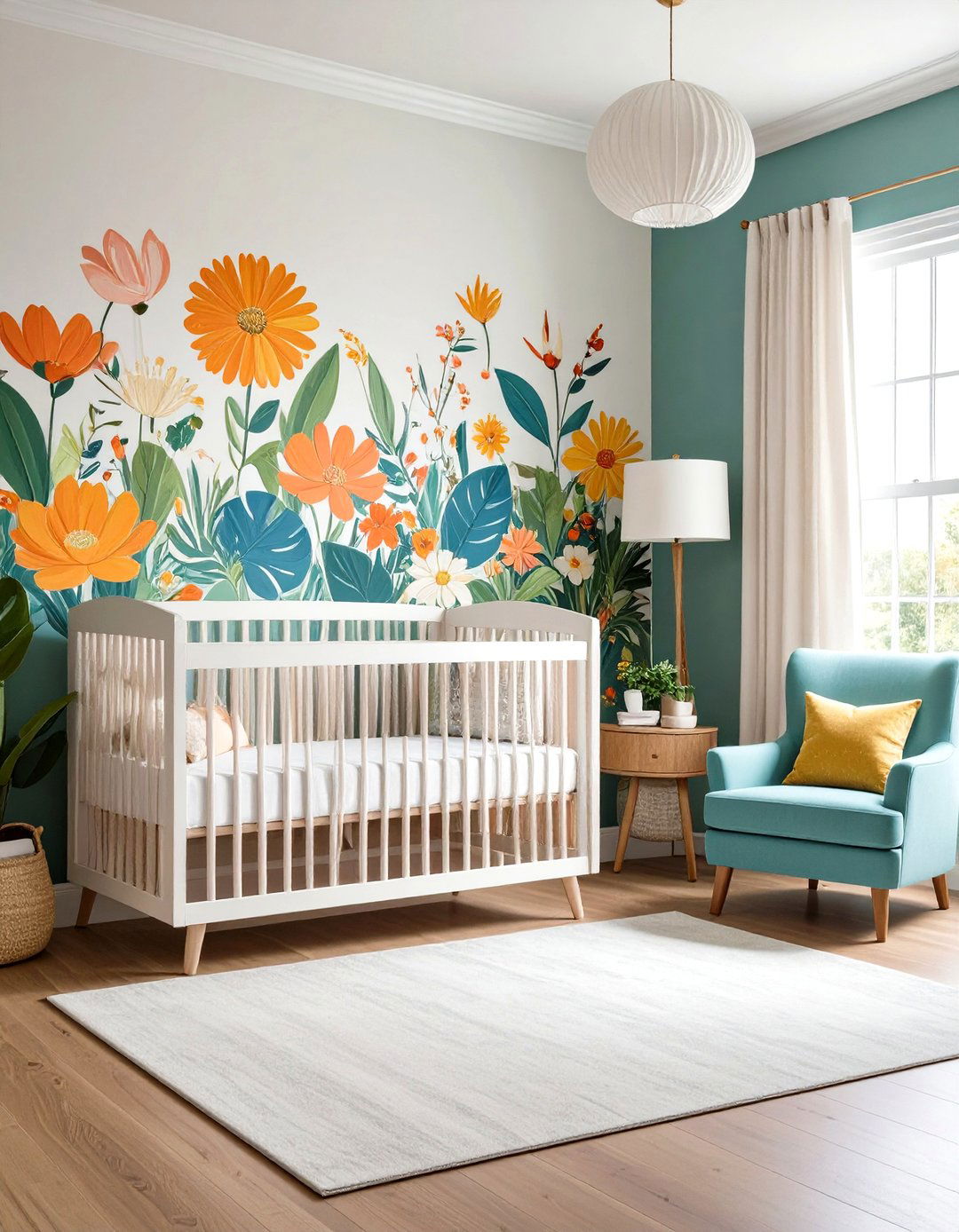
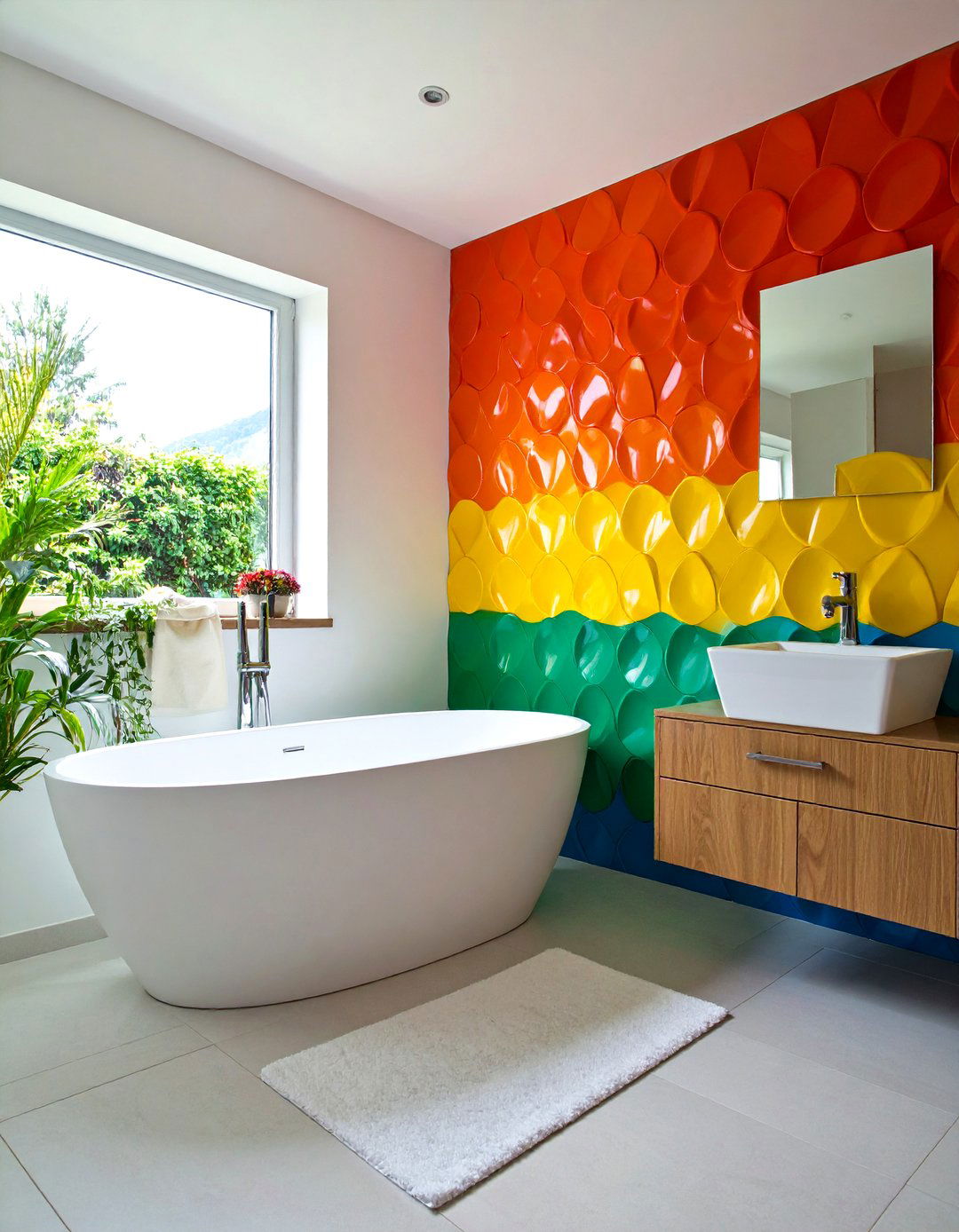
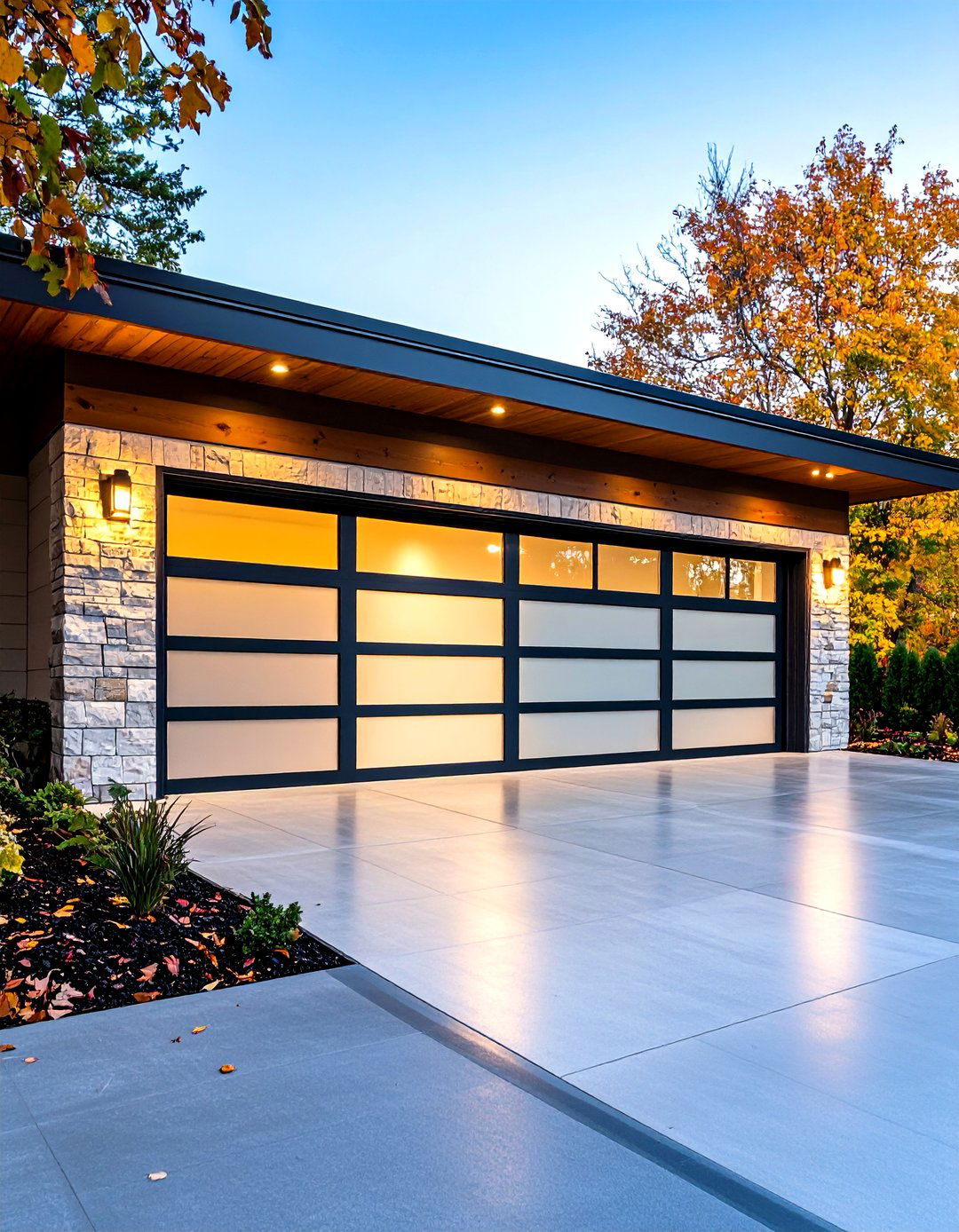
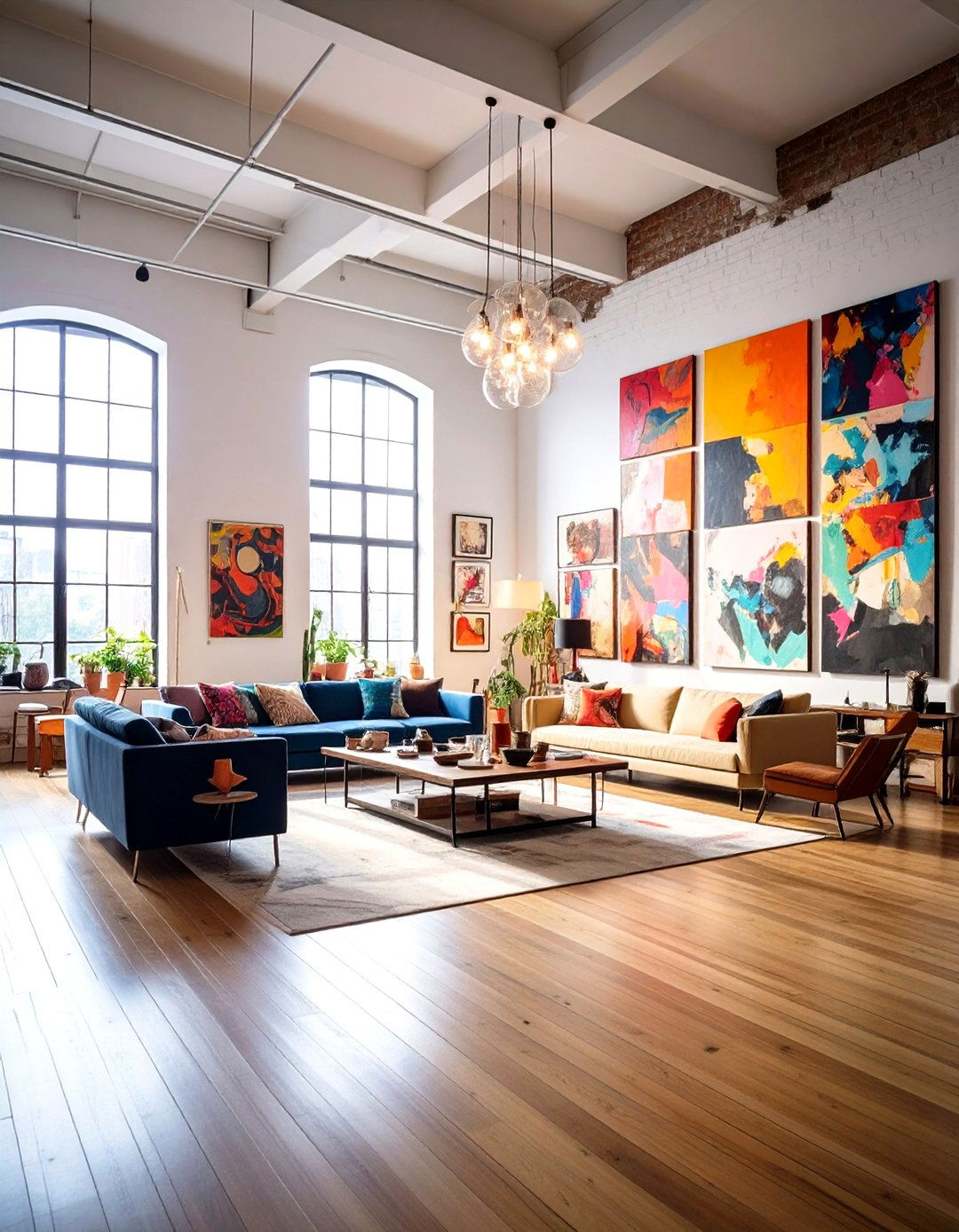
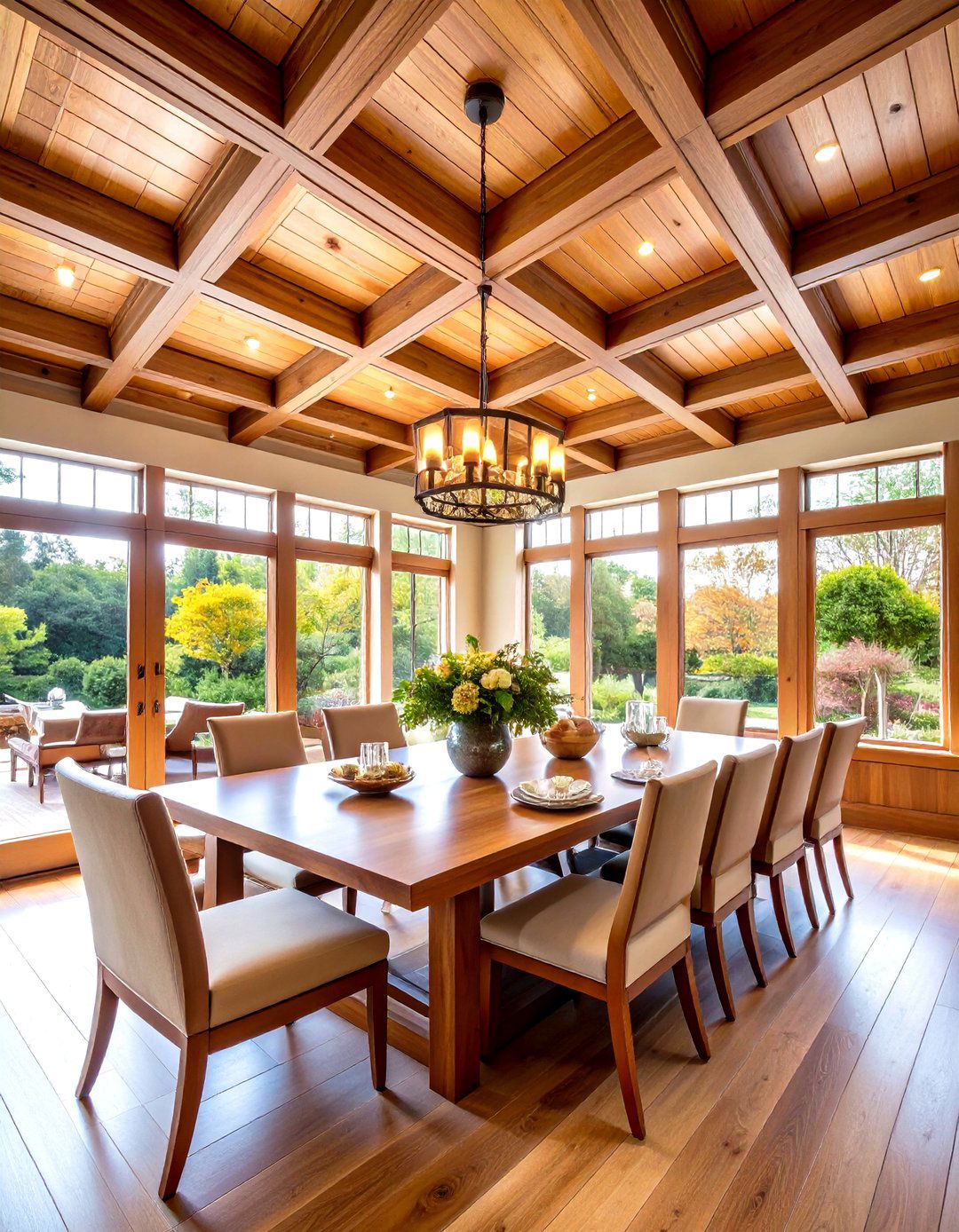

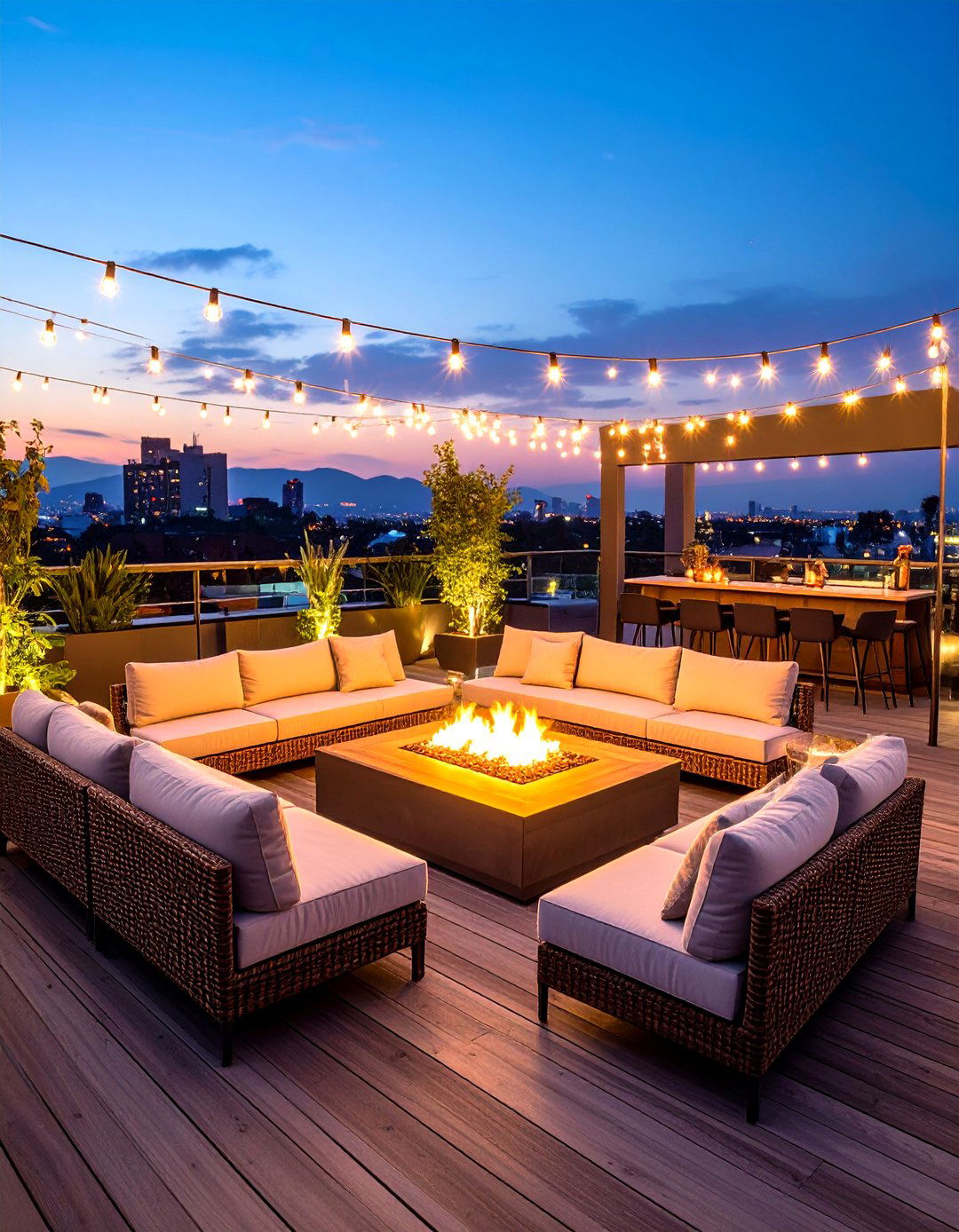
Leave a Reply